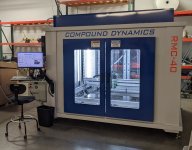jhiggi83
Member
I am considering picking up a decent 3d printer, either resin or filament. Something Like a Bambu X1C or Elegoo Saturn 4. I just want to ask how everyone else incorporates 3d printing into their pen making?
Appreciate the thourough writeup. I probably have all sorts of things I could use it for in the shop. I keep a lot of the stuff I use normally in a cardboard box next to my lathe that ends up scattered across the table topI use mine extensively for custom pegboard holders. All my MT2 stuff (centers, drill chuck, mandrel) and all my 1"x8tpi stuff (faceplate, 4 jaw chuck, collet chuck) are now stored neatly and accessibly on my pegboard. Also made a custom holder for some of the more incidental tools (drill chuck key, tommy bars for Nova chuck, pen tube reamers) that keeps them organized and handy
What printer did you get? For filament my research is pushing towards the Bambu P1s with ams2.Yeah, I second the Gridfinity. I plan on getting my tools organized soon. I photo'd the silverware to make custom pockets for gridfinity silverware organizer. It was a full week of printing. View attachment 386823
Yeah, no one believes the deal I got. I paid $115 for a NEW Ender 3 V2 Neo from BHPhoto Jan 2025. As I look and consider if I want to upgrade, I feel the need for multi-filament. Mostly to print supports in a different material. Supports can ruin a print. Currently, I design to avoid supports. I am not sure I want to print with resin. I make enough messes around here!What printer did you get? For filament my research is pushing towards the Bambu P1s with ams2.
Should also add I upgraded the printer firmware with Mricsoc. Added Raspberry Pi running Octoprint. Put's the printer on my wireless so I can control it from my laptop and camera support. Improved the experience by quite a bit. MrIscoc has some nice features, but the bed levelling made a big difference for me. Newer printers have the wireless built in. Pretty sure Bambu P1S has all that built in.What printer did you get? For filament my research is pushing towards the Bambu P1s with ams2.

